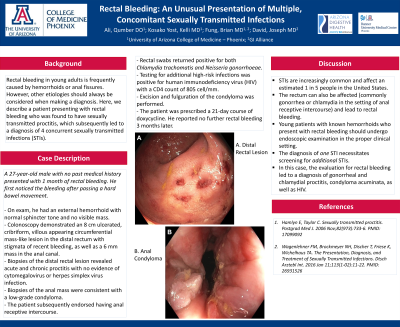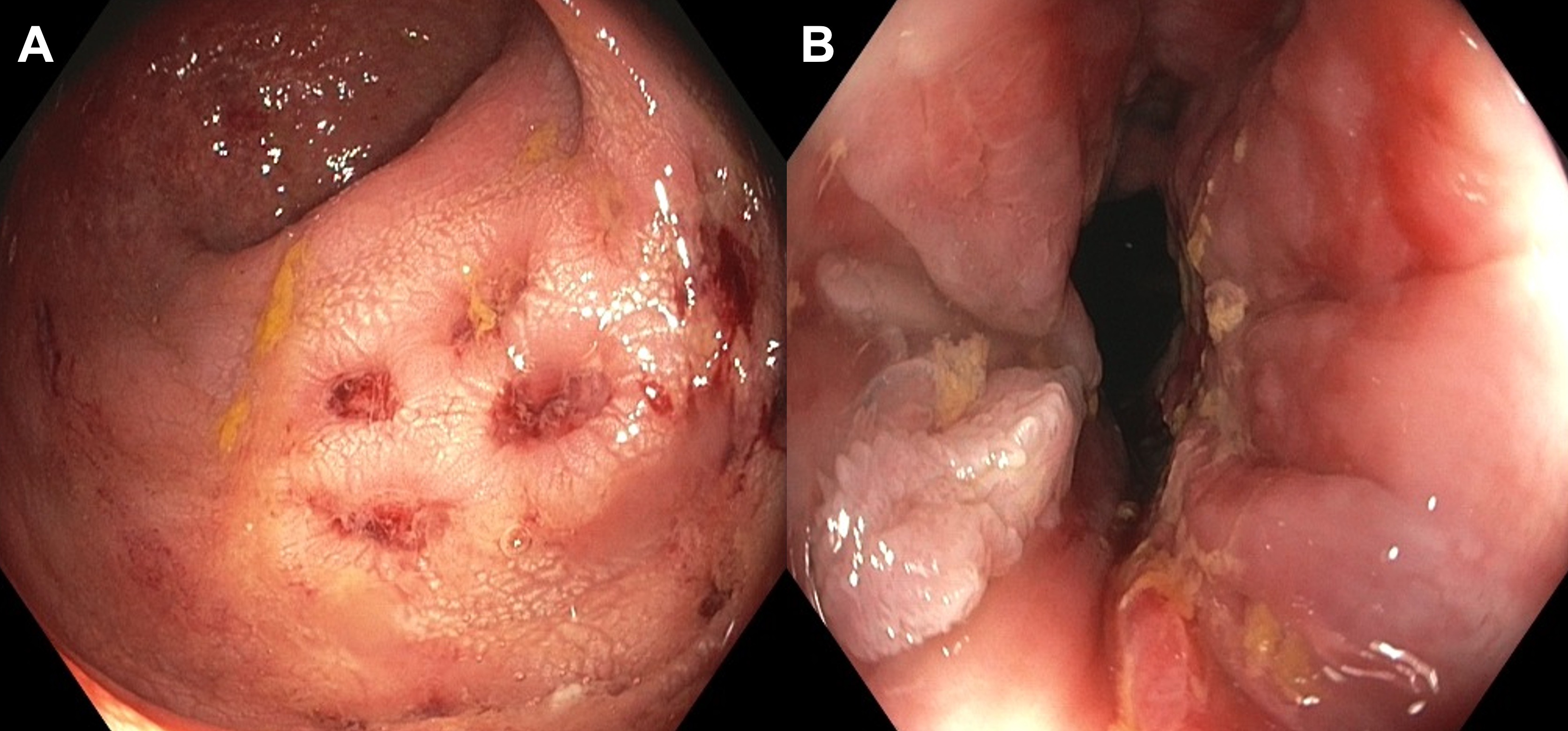Tuesday Poster Session
Category: GI Bleeding
P3481 - Rectal Bleeding: An Unusual Presentation of Multiple, Concomitant Sexually Transmitted Infections
Tuesday, October 24, 2023
10:30 AM - 4:00 PM PT
Location: Exhibit Hall


Qumber Ali, BS, DO
University of Arizona College of Medicine
Phoenix, AZ
Presenting Author(s)
Qumber Ali, BS, DO, Kelli Kosako Yost, MD, Brian M.. Fung, MD, Joseph David, MD
University of Arizona College of Medicine, Phoenix, AZ
Introduction: Rectal bleeding in young adults is frequently caused by hemorrhoids or anal fissures. However, other etiologies should always be considered when making a diagnosis. Here, we describe a patient presenting with rectal bleeding who was found to have sexually transmitted proctitis, which subsequently led to a diagnosis of 4 concurrent sexually transmitted infections (STIs).
Case Description/Methods: A 27-year-old male with no past medical history presented with 1 month of rectal bleeding. He first noticed the bleeding after passing a hard bowel movement. On exam, he had an external hemorrhoid with normal sphincter tone and no visible mass. Hydrocortisone suppositories were prescribed, and a colonoscopy was scheduled for further evaluation. Colonoscopy demonstrated an 8 cm ulcerated, cribriform, villous-appearing circumferential mass-like lesion in the distal rectum with stigmata of recent bleeding, as well as a 6 mm mass in the anal canal. Biopsies of the distal rectal lesion revealed acute and chronic proctitis with no evidence of cytomegalovirus or herpes simplex virus infection; biopsies of the anal mass were consistent with a low-grade condyloma. The patient subsequently endorsed having anal receptive intercourse. He was referred to colorectal surgery for treatment of the condyloma and rectal swab sampling. Rectal swabs returned positive for both Chlamydia trachomatis and Neisseria gonorrhoeae, and testing for additional high-risk infections was positive for human immunodeficiency virus (HIV) with a CD4 count of 805 cell/mm3. Excision and fulguration of the condyloma was performed. The patient was prescribed a 21-day course of doxycycline and referred to an infectious disease specialist for HIV management. He reported no further rectal bleeding 3 months later.
Discussion: STIs are increasingly common and affect an estimated 1 in 5 people in the United States. While the genitals/reproductive tracts are the most common anatomical locations for infection, the rectum can also be affected (commonly gonorrhea or Chlamydia in the setting of anal receptive intercourse) and lead to rectal bleeding. Key teaching points of this case are that even young patients with known hemorrhoids who present with rectal bleeding should undergo endoscopic examination in the proper clinical setting, and the diagnosis of one STI necessitates screening for additional STIs. In the above case, the evaluation for rectal bleeding led to a diagnosis of gonorrheal and chlamydial proctitis, condyloma acuminata, as well as HIV.

Disclosures:
Qumber Ali, BS, DO, Kelli Kosako Yost, MD, Brian M.. Fung, MD, Joseph David, MD. P3481 - Rectal Bleeding: An Unusual Presentation of Multiple, Concomitant Sexually Transmitted Infections, ACG 2023 Annual Scientific Meeting Abstracts. Vancouver, BC, Canada: American College of Gastroenterology.
University of Arizona College of Medicine, Phoenix, AZ
Introduction: Rectal bleeding in young adults is frequently caused by hemorrhoids or anal fissures. However, other etiologies should always be considered when making a diagnosis. Here, we describe a patient presenting with rectal bleeding who was found to have sexually transmitted proctitis, which subsequently led to a diagnosis of 4 concurrent sexually transmitted infections (STIs).
Case Description/Methods: A 27-year-old male with no past medical history presented with 1 month of rectal bleeding. He first noticed the bleeding after passing a hard bowel movement. On exam, he had an external hemorrhoid with normal sphincter tone and no visible mass. Hydrocortisone suppositories were prescribed, and a colonoscopy was scheduled for further evaluation. Colonoscopy demonstrated an 8 cm ulcerated, cribriform, villous-appearing circumferential mass-like lesion in the distal rectum with stigmata of recent bleeding, as well as a 6 mm mass in the anal canal. Biopsies of the distal rectal lesion revealed acute and chronic proctitis with no evidence of cytomegalovirus or herpes simplex virus infection; biopsies of the anal mass were consistent with a low-grade condyloma. The patient subsequently endorsed having anal receptive intercourse. He was referred to colorectal surgery for treatment of the condyloma and rectal swab sampling. Rectal swabs returned positive for both Chlamydia trachomatis and Neisseria gonorrhoeae, and testing for additional high-risk infections was positive for human immunodeficiency virus (HIV) with a CD4 count of 805 cell/mm3. Excision and fulguration of the condyloma was performed. The patient was prescribed a 21-day course of doxycycline and referred to an infectious disease specialist for HIV management. He reported no further rectal bleeding 3 months later.
Discussion: STIs are increasingly common and affect an estimated 1 in 5 people in the United States. While the genitals/reproductive tracts are the most common anatomical locations for infection, the rectum can also be affected (commonly gonorrhea or Chlamydia in the setting of anal receptive intercourse) and lead to rectal bleeding. Key teaching points of this case are that even young patients with known hemorrhoids who present with rectal bleeding should undergo endoscopic examination in the proper clinical setting, and the diagnosis of one STI necessitates screening for additional STIs. In the above case, the evaluation for rectal bleeding led to a diagnosis of gonorrheal and chlamydial proctitis, condyloma acuminata, as well as HIV.

Figure: A. Distal rectal lesion. B. Anal condyloma.
Disclosures:
Qumber Ali indicated no relevant financial relationships.
Kelli Kosako Yost indicated no relevant financial relationships.
Brian Fung indicated no relevant financial relationships.
Joseph David indicated no relevant financial relationships.
Qumber Ali, BS, DO, Kelli Kosako Yost, MD, Brian M.. Fung, MD, Joseph David, MD. P3481 - Rectal Bleeding: An Unusual Presentation of Multiple, Concomitant Sexually Transmitted Infections, ACG 2023 Annual Scientific Meeting Abstracts. Vancouver, BC, Canada: American College of Gastroenterology.
